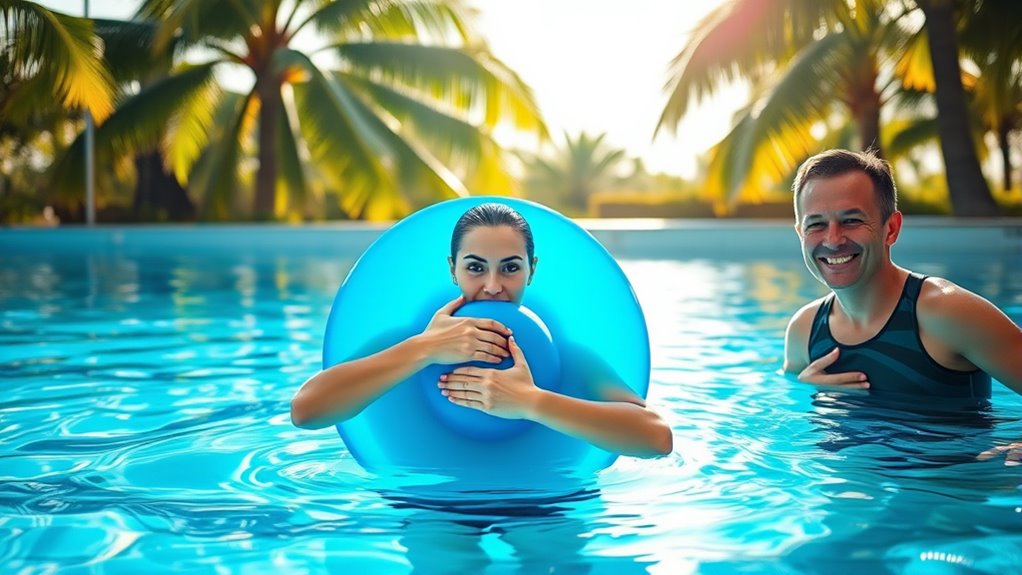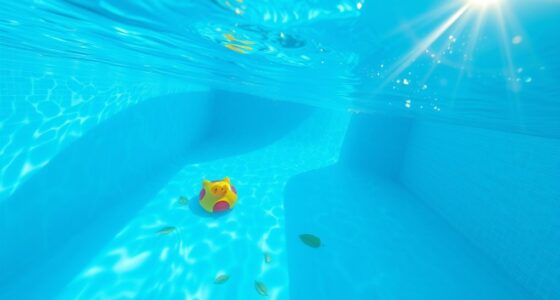To build confidence when learning to swim as an adult, start with small, achievable goals like floating or practicing breathing techniques. Always prioritize water safety by staying in designated areas and never swimming alone. Practice regularly to develop control and comfort in the water, and celebrate your progress along the way. Remember, overcoming fears takes patience—embrace each milestone because with steady effort, you’ll gain independence and enjoy the rewarding experience of swimming. Keep moving forward to *unleash* more helpful tips.
Key Takeaways
- Enroll in beginner classes or work with a trained instructor to receive personalized guidance and feedback.
- Start with floating and simple strokes to build comfort and control in the water.
- Practice regularly in short sessions to reinforce skills and boost confidence gradually.
- Set small, achievable goals to celebrate progress and stay motivated throughout your learning journey.
- Always prioritize water safety, swim within designated areas, and never swim alone to foster a secure learning environment.

Have you ever wondered if it’s possible to learn how to swim as an adult? The good news is, it absolutely is. Many adults find themselves hesitant or unsure about water, but with patience and practice, you can develop both skills and confidence. One of the most important aspects of learning to swim is understanding water safety. Knowing how to stay safe around water reduces anxiety and helps you focus on building your skills. Start by getting familiar with basic water safety rules: never swim alone, always stay within designated swimming areas, and be aware of your surroundings. Learning to recognize safe swimming zones and understanding how to react if you get tired or feel uncomfortable in the water are essential steps in gaining confidence.
Learning to swim as an adult is possible with patience, water safety awareness, and consistent practice.
When you’re just beginning, focusing on beginner strokes is necessary. These strokes are simpler and easier to learn, making them perfect for adults starting from scratch. The front crawl, breaststroke, and backstroke are foundational, and mastering these gives you the tools to move comfortably in the water. Don’t rush the process—start with floating exercises to get comfortable with water’s buoyancy. Practice breathing techniques, like turning your head to the side during front crawl, to improve your rhythm and endurance. As you become more familiar with these strokes, you’ll notice your confidence growing because you’re gaining control over your body in the water. Incorporating aquatic exercise into your routine can further enhance your comfort and strength in the water environment.
Another key to building confidence is setting small, achievable goals. For example, aim to float independently for a few seconds, then progress to swimming a short distance using beginner strokes. Celebrate each milestone; these small wins reinforce your progress and motivate you to keep going. Remember, everyone learns at their own pace, and setbacks are normal—what matters is consistency. Enroll in beginner swim classes or work with a qualified instructor who can give you personalized feedback and reassurance. Having an experienced guide can help you correct mistakes early on and develop proper technique, which ultimately makes swimming feel more natural and enjoyable.
Lastly, practice regularly—consistency is essential. The more time you spend in the water, the more comfortable you’ll become. Even short, frequent sessions can make a big difference. With patience, focus on water safety, mastering beginner strokes, and setting realistic goals, you’ll find yourself swimming with confidence before you know it. Remember, learning to swim as an adult isn’t just about skill; it’s about overcoming fears and gaining independence in the water. Keep pushing forward, and you’ll discover that swimming isn’t just a skill, but a rewarding experience that adds a new dimension to your life.
Frequently Asked Questions
How Long Does It Typically Take to Become Comfortable Swimming?
It usually takes a few weeks to a few months to feel comfortable swimming, depending on your dedication. You should practice breathing techniques regularly to improve your control and reduce anxiety. Using flotation devices initially can boost your confidence and help you get used to the water. As you gain experience and relax, you’ll notice your comfort level increasing, and swimming will become more natural over time.
Are There Specific Water Conditions Best for Adult Beginners?
You’ll find that a pool with warm water, around 82-86°F, makes learning much easier, as it relaxes your muscles. Shallow water, about 3 to 4 feet deep, allows you to stand comfortably while practicing without feeling overwhelmed. Sometimes, a gentle current or calm surroundings unexpectedly boost your confidence, making the environment feel safer. So, choose a warm, shallow pool to help you build confidence comfortably as you begin your swimming journey.
Can I Learn to Swim With a Fear of Water?
Yes, you can learn to swim even with a fear of water. Focus on water safety and take small, gradual steps to build your comfort. Practice mental preparedness by staying positive and patient with yourself. Consider working with a supportive instructor who understands your fear. Remember, overcoming water fear takes time, but with consistent effort and a calm mindset, you’ll develop confidence and enjoy the benefits of swimming.
What Are Common Mistakes Adult Learners Make?
Ever feel like you’re trying to tame a wild beast in the water? That’s a common mistake adult learners make. You might rush, skip breathing techniques, or neglect proper gear. Focus on steady breathing and use the right equipment to build confidence. Avoid rushing through lessons; patience is key. Taking these steps helps you stay relaxed, making the water your ally rather than an adversary.
How Often Should I Practice to Improve Quickly?
You should practice consistently, ideally 2-3 times a week, to see quick improvements. Set clear goals for each session, focusing on specific skills like floating or breathing. By maintaining regular practice and tracking your progress, you’ll build confidence faster. Remember, consistency is key, so sticking to a routine helps solidify your skills and makes swimming feel more natural over time.
Conclusion
As you take those first strokes and conquer your fears, you realize that sometimes, life’s surprises come when you least expect them—like discovering a new passion at the perfect moment. Learning to swim as an adult isn’t just about mastering water; it’s about trusting yourself and embracing new challenges. So, keep going, because the confidence you build might just lead you to unexpected adventures—reminding you that it’s never too late to plunge in.








